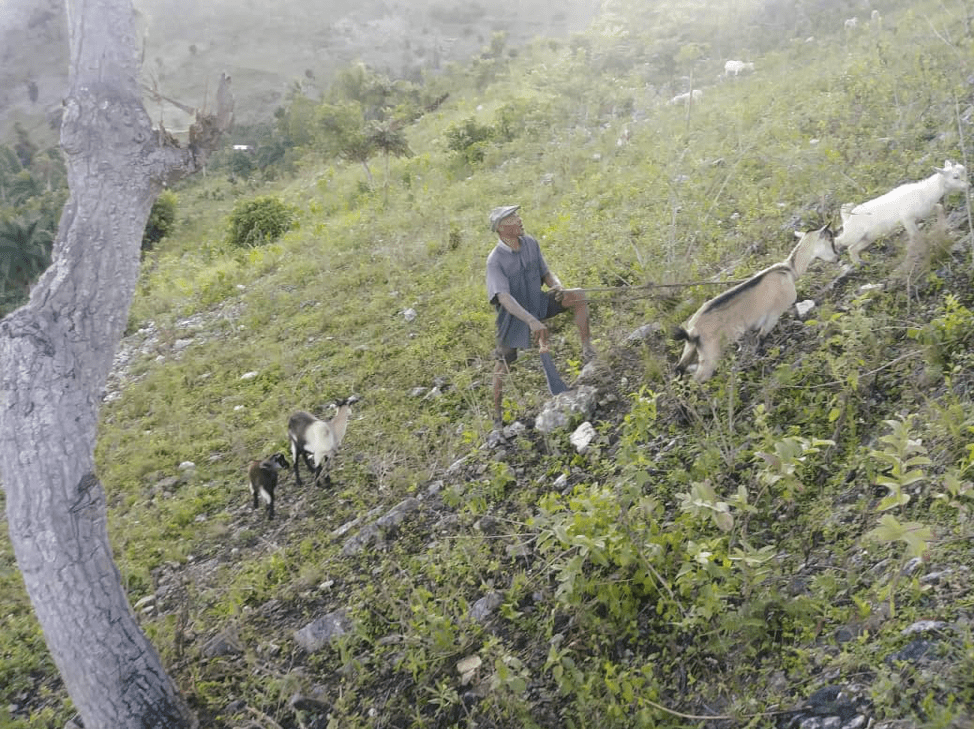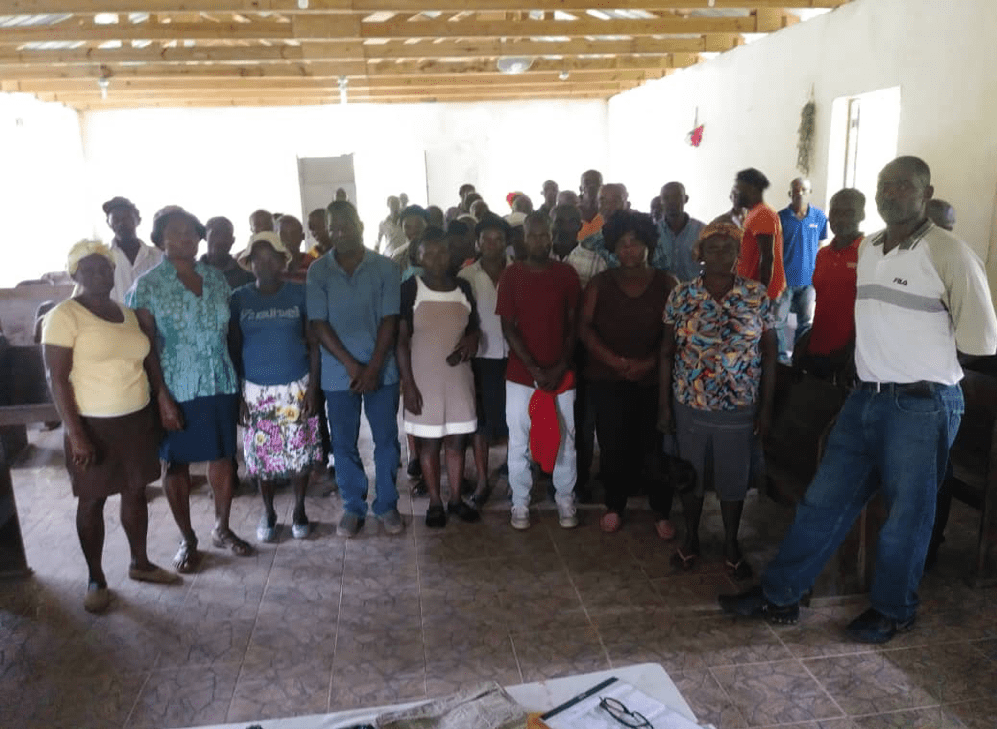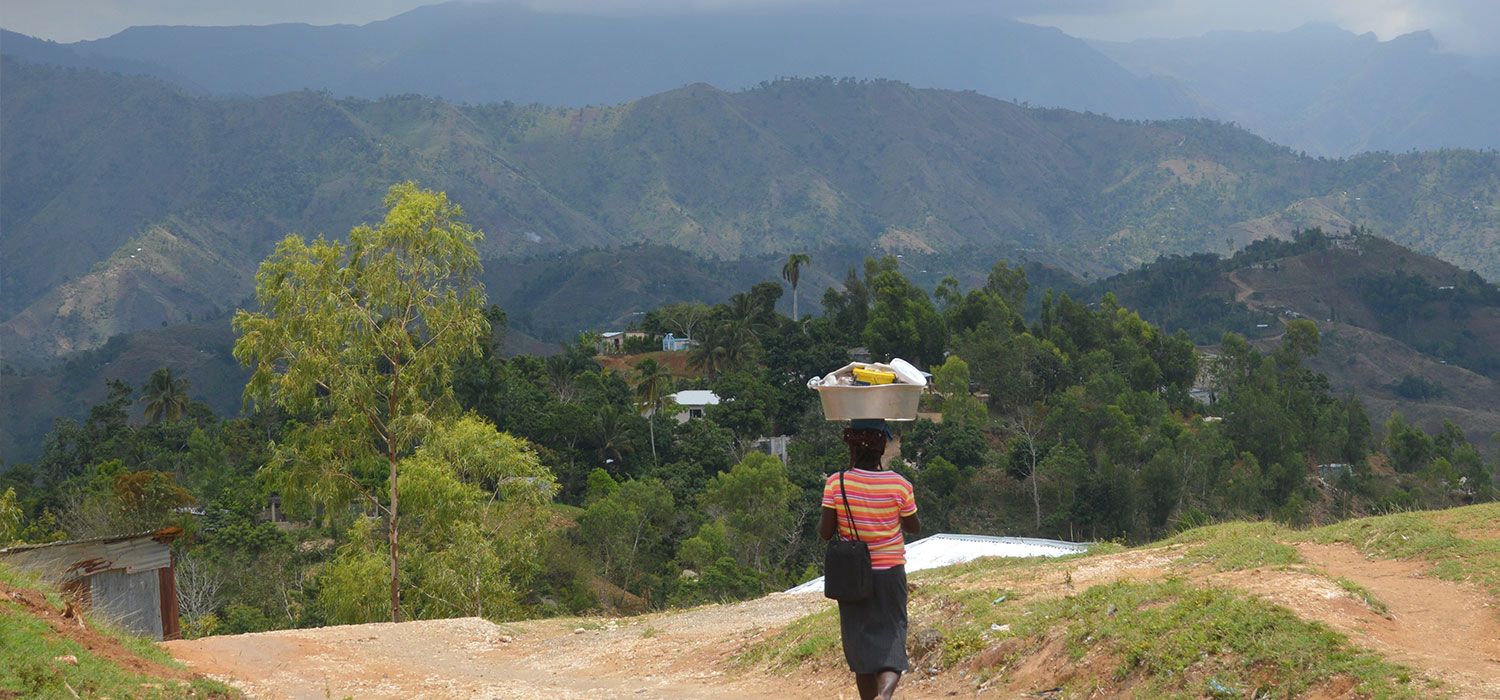High social and economic vulnerability combined with deforestation and environmental degradation is a situation that is almost everywhere in Haiti. However, the way that affects each region of the country and how to solve it are to be known. Observers suggest that identifying a problem is having it half way solved. This is may be the background that is behind the assessment of the needs that was undertaken in four (4) different communities in Haiti. These communities are: Mancelle (Gros Morne), Peredo, Boury and Haute Voldrogue (see fig.1).

Figure 1: Timote Georges during posting with leaders of farmer's Association of the community of Gros Morne(Mancelle)
During the month of April through May 2019 SFA Agronomists; Timote Georges and Abel Dorvilne, led several field visits in each of the above communities.
The aim was to listen to the farmers, and observe their natural landscape in order to understand their local challenges on behalf of better development initiatives in the future. To do this task we interviewed: local people, leaders, and local government representatives. We also held several community meetings and observed the local vegetations.
The report gives a brief presentation of the geographical locations of each of the four communities to conclude later with a few recommendations for possible actions in the future.
1. Presentation of the four communities
In the tables below (from table1,2, to Table 3), I outline each of the four communities’ geographical location (see table 1), I summarize what they have in terms of local development infrastructure, a general consideration on all of them together, and to finish with recommendations for future actions.
Table1: Geographical locations of the 4 communities in Haiti
| Boury | Peredo | Haute Voldrogue | Mancelle (Gros morne) |
|---|---|---|---|
| Boury, is the first communal section of the municipality of Torbeck in the Southern part of Haiti. Boury is a community with a total landscape of 42.6 km2 and about 3095 households are living in this community. | The communal section of perédo is located in the Department of Southeast, its size is 31.48 km2 and 71112 inhabitants, for 9500 households live in Peredo. This community is located about 20 km from the city of Jacmel in the Southeast region of Haiti. | The municipal section of Haute Voldrogue is located in the Department of Grande Anse, a vast expanse of land whose population is estimated at about 49000 inhabitants. It is located about 14km from the city of Jérémie, the main city of the geographical Department of Grand-Anse. | Mancelle is one the biggest communal section of Gros Morne in the geographical department of Artibonite. This community has 13014 inhabitants and it is an area of 37.95 km2 according to the Haitian Institute of Statistics (IHSI 2009). |
1.2 Infrastructures (Roads, Health, education, religion and farmers’ organizations)
Table 2: Existing development Infrastructures in the communities
| Boury | Peredo | Haute Voldrogue | Mancelle (Gros morne) | |
|---|---|---|---|---|
| Road infrastructure | In terms of road infrastructure, there are several breakthroughs that lead to this community which represents the bastion for other neighboring localities. However, Boury is crossed by the National no 2 coming from Cayes. This road gives access to three small markets and a large one. | The main road to Peredo from the city of Jacmel is road Trois- cents- Ans that leads until the Dominican Republic and several breakthroughs leading to nearby localities. It considers itself to be the landmarks for other neighboring localities | There is only one main entry which is the Leon’s road that accesses Voldrogue from Cayes. Haute Voldrogue has also several breakthroughs that drive to other smaller neighboring communities. | Road access to Mancelle is almost inexistent. Big truck can afford it only during drought season. But the most common transportation mean remains motorcycle and walking/hiking. Given this situation transporting local agricultural products to the main market in the city of Gros morne is a big challenge. |
| Health infrastructure | Boury has two health centers that serve local population. But inhabitant living far away cannot afford to travel mostly because of travel cost that too much for farmers. This makes the health centers less useful while most people refer to traditional medicine techniques to take care of themselves. | The population of the communal section of Pérédo faces enormous health difficulties; These types of diseases are dominant (fever, influenza, cholera, hernia infection of all kinds, etc.). There is only one health center that does not meet the needs of the population. No pharmacy, no lab, no specialty services. All this forces people to go to Cayes or to Jacmel to receive necessary cares. | Haute Voldrogue has serious medical problems. People are hit by different diseases such as: malaria, cholera, influenza, hernia, several types of infection). Despite the presence of two health centers, people have to travel to the main city of Jeremie to find appropriate cares because the local health centers are very much limited in terms of capacity of response. | The sections of Ka labat and Chateau within Mancelle community host two health centers that are not fully operational given the absence of necessary equipment and human resources to operate them. The common diseases in the community of Mancelle are Low and High blood pressure, AIDS, malaria, influenza, and prostatitis |
| Education | The school situation in Boury is characterized by low coverage of school infrastructures (building). The few school buildings that exist have their classrooms in bad shape therefore poor education becomes obvious. About 80% of young people are enrolled in school. | The education system in Peredo is characterized by lack of qualified professors, necessary tools . Some establishments reach secondary level. Students must go to Marigot or Jacmel to complete their studies if parent’s economic condition allow it. An estimation of 85% of the young people attend school. | Education level in Haute Voldrogue is limited only to the secondary level. For advanced studies or for technical /professional education, students are obliged to travel to Jérémie where they find appropriate school levels. | Mancelle has a lot of school buildings. Twenty ( 20) schools are built but the quality of education is poor. Lack of trained teachers, incapacity to pay well trained professors from outside and lack of other educational tools are barriers to quality education on behalf of the children in Mancelle. Students have lot of difficulties to advance their education dream beyond just that system |
| Religion | In Boury there is a diversity of religions of different beliefs (Protestant, Catholic, Vodooism, etc.) People are free to practice what they believe in | In Peredo there is also a diversity of religions with different base faith: Catholic, Protestant. In parallel to these, there are traditional practices that mostly took root from vodooism | Several religions with different beliefs. Examples are Catholic, Protestant, and seventh day church. In parallel to these there are also traditional practices that mostly take root from vodooism. | Protestantism and voodooism are dominant in Mancelle. Inhabitants are free to exercise their faith based on their choice. |
| Local organization | In Boury farmers get organized. But with a poor leadership to keep members focus on long term goals. The local organization needs to be more structured. | The traditional farmers’ associations exist in Peredo. Each farmer belongs by default to a group that does agriculture, work party to help each other. But still the local leadership needs to be strengthened | Farming associations exist as a tradition in the community of Haute Voldrogue . Farmers are willing to work together for the benefit of the community and for themselves. But that will happen only if there is an appropriate leadership | Farmers in Mancelle are also grouped as associations. However, the local leadership to keep the associations alive and to pursue long term goal is part of the major handicap for Mancelle development. |
1.3 Agro-ecological conditions of the communities
| Boury | Peredo | Haute Voldrogue | Mancelle (Gros morne) | |
|---|---|---|---|---|
| Soil | Boury has three types of soils: 1) black in color with a silvery-clay texture covering more than 50% of the area. 2) Hydro morphs rich soils in organic matter. This category is dominant in the low lands with a clay texture 3) The third category is formed with soils of brown color with a Sandy texture but easy to work. | Peredo has three types of soils: 1) Sandy-clay soil of red color 2) Light brown Sandy sand easy to work 3) Clayed and hydro morph soil, rich in organic matter | 1) Red-colored clay-sandy; 2) Clay in texture - black soil in color, but very productive | The soil in Mancel has two main characteristics depends on the topography. In the low land are found sediments that are 60 to 80 cm deep, the soil is practically sandy. In the hills the soil results from the alteration of its physical parts example rocks. This process of degradation of the mother stone gives birth to dioritic and basaltic soils |
| Hydrology | Boury has relatively large water resources, many rivers cross the commune, examples are: Redon, Poles, Desrodières, Boury and Acul rivers. But the most important watercourse is that of the river of Torbeck which particularly irrigates the first communal section of Boury | In Peredo there are relatively large water resources flowing through the community. Examples include: felle River, cave River, and citronnier River. The most important is the Felle river that waters the most of the lowlands of Peredo | In Haute Voldrogue water sources and rivers are not in good condition (visibly polluted). The Voldrogue’s river that crosses the farming area used to flood an important part of this community when it rains. Water availability does not contribute to the people wellbeing | The main river of Mancelle is Mancelle river that crosses the city of Gros Morne when it rains. Mancelle has water available all the season even during the drought. But no irrigation infrastructure in place to take advantages of the availability of this resource (water). |
| Climate | Boury is between 0 and 200 meters in altitude. There is a tropical climate with two dry seasons and two rainy seasons that alternate over the years. A small rainy season, March-may; A dry season, June-July; A great rainy season, August-November; Another dry season is from December-February. | Pérédo enjoys a tropical humid climate affordable to all kinds of agricultural activities. It has two dry seasons and two rainy seasons. Dry season is from November to February Rainy seasons are from March to April and August to October | The community of Haute Voldrogue has a humid tropical climate that is beneficial to agricultural development. It has two dry seasons and two rainy seasons. Dry seasons are from November to January and from June to July The Rainy season is from February to may and August to October | The climate in Mancelle is relatively warm in the summer and cool during the other season. The rainy season starts in May through June and another one that starts in October towards the end of the year. |
1.4 Agriculture and Environment
Table 3: Local condition regarding agriculture and Environment
| Boury | Peredo | Haute Voldrogue | Mancelle (Gros morne) | |
|---|---|---|---|---|
| Agriculture | Lack of economic resources to procure agricultural equipment and better seeds quality makes agriculture unable to contribute to decreasing poverty and hunger in Boury. At another brief, the absence of technical guidance either from the government or the private sector is a big challenge. The current subsistence agriculture is made with rice, maize, sorghum, banana, and potato production and remains the main source of livelihood for the community | The main crops of Peredo are: banana, breadfruit, mango, corn, black bean and vegetables (Eggplant, pepper, beet, tomato) Lack of economic resources to purchase agricultural equipment, amplified with absence of technical support prevent farmers from being able to produce effectively | The main crops of Voldrogue are: banana, maize, black bean, cassava, Malanga, and Yam. Lack of economic means to purchase agricultural inputs at the beginning of agricultural campaigns are the biggest challenges | Agriculture is considered in Mancelle as the main source of livelihood. Farmers produce mayz, plaintain, beans, yam. The agriculture is a form of subsistence one. There is no real intervention of the related government agency in the area to develop this sector regardless its importance for each Haitian. |
| Natural environment | The general landscape of Boury presents very low vegetation. Despite this situation, strong pressure is applied by cutting down the trees as a way to get compensated for being economically deprived. Unsanitary nature of the poor management of solid and liquid wastes leads to pollution of surface and ground waters. The natural vegetation is dominated by remaining of coconut, breadfruit, avocado, mango, bamboo, cedar, cherry, and oak trees | This community has low tree cover because of the long tradition of abusing the natural vegetation. Even that, the natural environment is flourished with some coconut, breadfruit, avocago, mango, cedar, mahogany, pine, and oak trees | The community of Haute voldrogue is environmentally degraded. There is a system of accelerated logging of trees, pollution of water that is amplified by upstream anarchic urbanization. In the downstream either bad agricultural practices go jeopardizing the natural environment. Both trees exist there: Fruit and forest trees like: mango, avocado, breadfruit, coconut palm, cedar, cassia trees. | In Mancelle the vegetation is about 45% green. The tree cover in this area is relatively acceptable. The tree species encountered are xerophytic in nature while the fruit trees are mangoes, avocadoes, coconut tree. In some localities of Mancelle there are also Neem trees, catalpa longitissima and swietenya macrophylla trees |
1.5 The main economic activities of the farmers
| Boury | Peredo | Haute Voldrogue | Mancelle (Gros morne) |
|---|---|---|---|
| In Boury, the main economic activities of the farmers are: trade of imported rice, maize, black bean, sorghum, potato, banana, eggplant, tomato, charcoal, and livestock (pork, beef, sheep, goats) and fishing. | The economic situation of Peredo is based on the following activities: women farmers trading imported and local maize, black bean, potato, banana, breadfruit, mango, eggplant, tomato, livestock (pork, beef, sheep, goats), fishing. selling handicraft/artisanal and charcoal are very common economic activities | Economically, agriculture is the first source of income for the population of haute Voldrogue. Inhabitants sell their agricultural products, and their livestock to sustain their life. | Inhabitants of Mancelle generate income by trading their locally-grown agricultural products like: beans, plantains, Mayz, yam, cassava They also sell their livestock as a secondary economic activity and third one is a combination of doing motorcycle taxi as a business for the young boys. Selling handicraft, making charcoal for selling in the city of gros -morne are also important activities in Mancelle. |
2. General observations and needs
The needs observed in these 4 communities are in various sectors but we retain the following sectors:
- Agriculture
None of the four (4) communities has an on-going support from the Haitian Ministry of Agriculture or from a Nongovernmental Institution. Except, in the community of Boury where Brana, the breeding company of Haiti that helps some of the farmers to plant sorghum in order to sell it back later to this same company. In agriculture the general view shows that the farmers of these communities are left behind. As in this situation they are faming in an inappropriate technical way while the natural potential of the soil to produce does exist.
- Environment
The communities had in the past two decades significant tree cover. However, deforestation is changing this traditional pride to make them the most deforested place in the Southern zone of Haiti. Deforestation is currently happening in the four communities mainly because people are economically deprived. Given their situation they cut down trees to make charcoal and sell it to the urban areas (some income is generated). Another aspect that makes deforestation even worst is that most of the fruits trees for instance the citrus spp were taken away during the passage of Matthew hurricane at the end of 2016 are still have to be replaced (see fig.2). All the four communities, being in the process of environmental degradation are suffering from Biodiversity lost, ground water scarcity, irregularity in the rainy season, soil erosion, weak agricultural productivity and more vulnerability to natural disaster.

Figure 2: A farmer in Haute voldrogue (Jeremie) witnessing his land becoming fruitless because of deforestation
- Infrastructures/Economy
Health, Education, and Roads infrastructures are ineffective in the communities where they exist. The absence of rural roads for example obliges women to use their own shoulder, their animal or sometime a motorcycle taxi to carry food commodities to/from nearby market. Their economy is basically an informal one. In parallel to that, farmers do not have full advantages of their locally grown products because when they go to a market, they cannot afford to take a taxi to return home with the remaining merchandises. Given that situation, these remaining products are sold at the price offered by the buyer. In short, they produce not enough but what is produced is wasted.
- Tradition with planting cotton spp and Moringa oleifera
Three of the communities (Boury, Peredo and Voldrogue ) have the tradition of planting both moringa and cotton. The local farmers of these three communities have mentioned that they had the tradition of selling cotton to IDAI[1] in the past thirty years from now. They produce moringa for their own local consumption (see fig. 3).
[1] Institute of agriculture and Industrial development

Figure 3: Farmers in Boury, after their meeting with SFA Agronomist
This situation is different for the community of Mancelle that only does moringa.
- Local Organizational capacity
In terms of local organizational capabilities. All the communities have at least one existing farming associations but with a weak organizational structure and therefore poor leadership. We describe that as a possible impediment to internal success in development.
3. Recommendations for future actions
Instead of recommendations, we want to share our suggestions as they resulted from a mix of what we have seen and what residents identified as priorities. We only consider needs that are in the field of: Agriculture, Environment, and economic development
It is unquestionable that farmers from all the communities are suffering from these problems: Deforestation, weak agricultural productions, absence of market to purchase the few products they have, lack of financial resources for the women with this ability to do trades with neighboring markets. Because of these facts, I propose that these items be considered as target in the future plan of development on behalf of these communities:
- Agroforestry/Tree planting
- Support of local agricultural production
- Agribusiness by developing sustainable value chains (ex: cotton and moringa for Boury, peredo, and Haute Voldrogue and Mango for Gros morne /Mancelle) with the aim to link farmers to buyers
- Animal husbandry programme that is sustainable enough to itself generate an animal to pass as a gift to each farmer over time (livestock is farmer’s bank account).
- Micro finance on behalf of women farmers that have habit on commerce
Knowing that environmental rehabilitation and Agroforestry/agriculture task require time before they can take effects; A five- year plan to develop activities 1,2,3,4, and 5 coming as a package could be a good timing to train and to give examples to these communities on how to solve issues. The approach to accomplish that should be a bottom up approach that prioritizes local engagement in all the steps of the project. While working with farmers, a focus must be on strengthening the local organizational structure of the farming associations in order for the farmers to be able to pursue and keep objectives in a long-term prospect.


